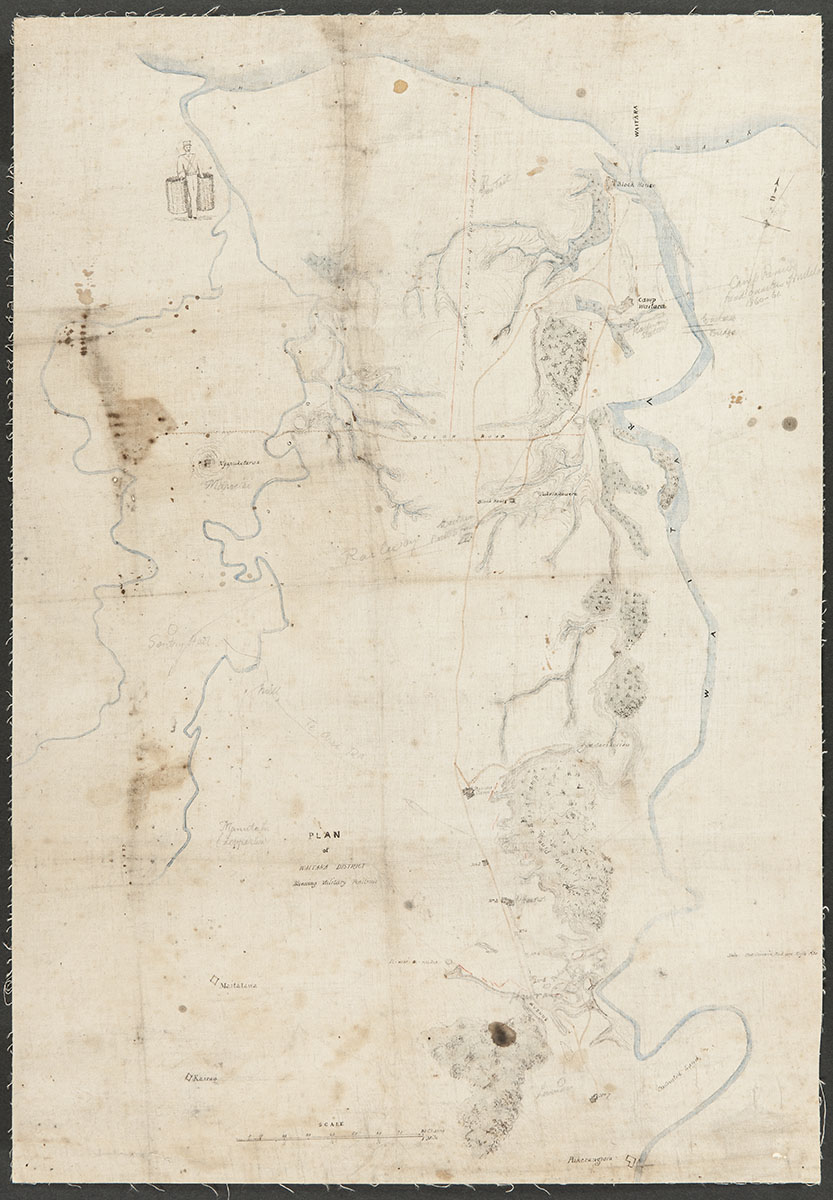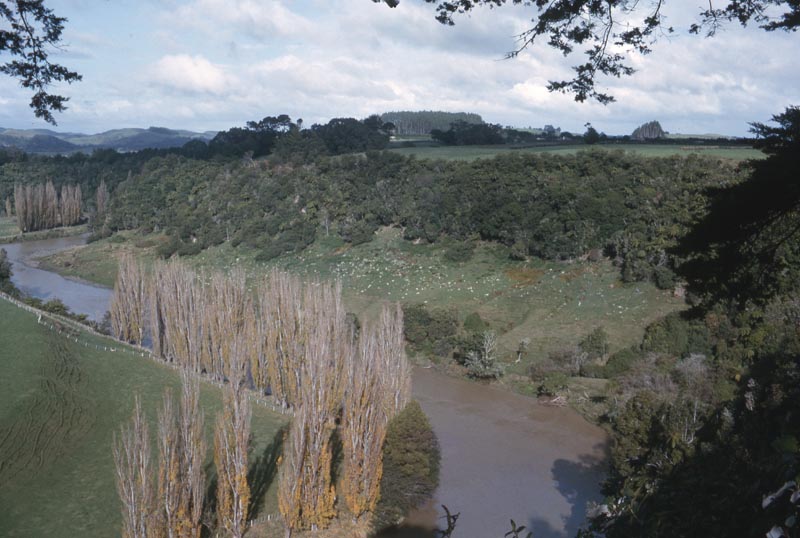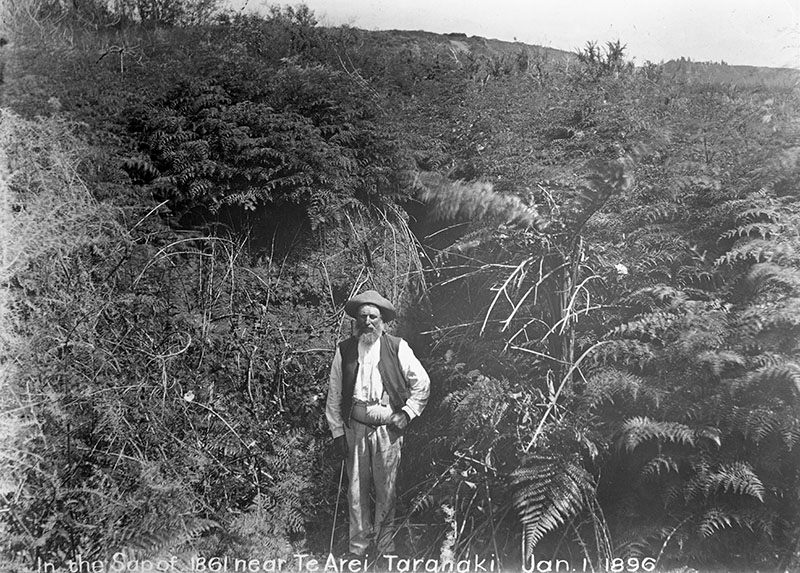



Ghosts walk at Pukerangiora. They whisper as you move your feet. Brush your elbow as you bend through the trees. Watch you step close to the cliff-face to watch the Waitara River wind far below you…
To get to Pukerangiora, take the Waitara Road that follows the right bank of the Waitara River, heading east from the coast. Soon you'll find the remains of Te Ᾱrei pā. Te Ᾱrei means 'the barrier' and that's exactly what it was, a fighting pā, designed to protect the stronghold of Pukerangiora which rises behind it.
Pukerangiora is one of the most ancient pā around, the old home of the Pukerangiora hapū of Te Ᾱti Awa. It sits about 8 kilometres upstream from the Waitara River mouth, on a spur of land that looks out towards the ocean in the distance. It rises about 100 metres above the water on a sudden loop in the river.
On the flat below, the deep zig-zag cuts of the military sap remain, dug to help British soldiers evade enemy fire. Eight redoubts were built in this area and bullets can sometimes still be found in the soil under your feet.
In the early part of the 1800s, the area was extensively planted with maize, potato, kūmara, taro, calabash, melon and pumpkin crops. Kererū, kākā and tūī were abundant and the river ran thick with eels.
The famous meeting house Te Waha o te Marangi or 'Door to the East' stood close to the edge of the cliff. Those stepping outside the doorway could look across the Waitara Valley all the way to the waves.
But in 1831, the Ngāti Maniapoto arrived from Waikato and embarked on siege and slaughter of such savagery, the land ran red with blood and Pukerangiora would never be the same again.
In 1821 a large war party (taua) of some 600 Ngāti Whātua, Ngāti Tīpā, Waikato and Ngāti Maniapoto warriors arrived in north Taranaki, from a journey down south. As guests of the Te Ᾱti Awa, they rested at Rewarewa pā near the mouth of the Waiwhakaiho River. But their Te Ᾱti Awa hosts were not quite as hospitable as they thought. Unbeknownst to them, the chief had sent a message to iwi at Waitara, telling them to let the taua cross the Waitara River and then take them by surprise. But the Waitara hapū were too anxious to fulfil the orders, and their attack failed to defeat them. The warriors of the taua took refuge in the small pā of Ngā Puke Turua.
Members of Te Ᾱti Awa argued over whether to let the taua go home unharmed or to take them prisoners and make them into slaves. In the end the taua simply left of their own accord and made their way to Pukerangiora. There, Te Ᾱti Awa erected a palisade around the pā until 1600 people were penned inside the southern section known as Kai Katea. Soon Te Ᾱti Awa changed its name to Raihe Poaka (The Pig Sty).
It took seven long months of siege before one captured warrior made it through Te Ᾱti Awa lines, taking word of the fate of his fellow warriors to the Tainui confederation in the Waikato district.
By now, Te Rauparaha was making his way to Taranaki with his 1500-strong Ngāti Toa force. He had faced so many wars with Waikato - and for so long - he decided to join his Te Ᾱti Awa allies before heading further south to settle in peace on the Kapiti coast.
When Te Wherowhero, head of the Tainui confederation and leader of the Waikato, heard that his iwi was under siege at Pukerangiora, he too collected his warriors and headed south to attempt a rescue. He had decided to teach Te Rauparaha a lesson at the same time. But when Te Wherowhero caught up with Te Rauparaha at Urenui, on a plain called Motunui, he found himself engaged in a battle he unexpectedly lost. It was a defeat he never forgot.
After the fierce fight, all the Waikato survivors fled to Pukerangiora to join their besieged iwi in The Pig Sty. There they stayed for a number of weeks until, for reasons that are still unexplained, Te Ᾱti Awa lifted the barricades and let them go home.
Te Rauparaha continued on his way to Kapiti, while Te Ᾱti Awa strengthened their pā in the knowledge that one day Waikato would return to seek revenge. They knew Te Wherowhero would never forgive the defeat at Motonui or forget the shame of being held captive in The Pig Sty at Pukerangiora.
They were right. In 1831, Waikato came back with 680 warriors and took a pā at Urenui. From there they went to Waitara, destroying crops and whare.
When Te Ᾱti Awa saw the strength of this new war party, they ran to their largest and safest fort - Pukerangiora. They had hardly reached sanctuary behind the palisades before the buffer zone of Te Ᾱrei was attacked. The next day they were attacked again, but the pā did not fall. They watched Te Wherowhero and his warriors set up camp outside the gates.
An estimated 4000 Te Ᾱti Awa were now trapped in the same pā that had once held their enemies. With no time to gather crops, the storehouses lay empty and everyone inside soon suffered hunger pains. Though Ngāti Tama came down from Pukearuhe and Tongapōrutu and camped on the northern bank of the river in a bid to help their Te Ᾱti Awa allies, they saw the Waikato force was too powerful and well-armed with muskets to defeat, and so they went home again.
After three months without rations, those held at Pukerangiora knew they had two desperate choices: to leave to find food or die inside. Te Ᾱti Awa decided to flee, but instead of making an escape under the cover of darkness, they began a mass evacuation in broad daylight. Te Wherowhero's warriors ran them down, launching into a slaughter of such brutality and magnitude that bloody stories still abound today.
It is said at least 200 escapees died immediately, with Te Wherowhero killing 150 single-handedly with blows to the head. It was only when his arm grew tired and swollen he was forced to stop. Those with finely tattooed faces were beheaded carefully on a wooden block so their heads could be preserved. Later, dozens of slaves were dragged away, carrying the heads of their relatives to be hung as war trophies in the Waikato villages in the north.
It is thought that as many as 1,200 Te Ᾱti Awa people lost their lives at Pukerangiora. Those that stayed behind in the pā watched the terrible fate of their whānau unfold before them. The scene that followed was terrible, with huge numbers of the dead gutted and spit-roasted over fires. Some Waikato warriors indulged in a feast of such gluttony, they died. In desperation, women threw their children off the cliff into the Waitara river and jumped in after them, rather than have them captured alive.
After the slaughter Waikato marched south, sacking Puke Ariki and Pūkaka until finally they reached Ngāmotu. Here they fought a fierce battle for Ōtaka pā but lost unexpectedly when Te Ᾱti Awa managed a surprising victory with the aid of whalers Dicky Barrett and Jacky Love. For the first time in battle history, Te Ᾱti Awa had muskets and cannon power.
But the fall of Pukerangiora wrecked the Te Ᾱti Awa people, who knew it was only a matter of time before their enemy returned yet again for utu. Leaving only a handful of iwi to keep claim to their land, they began the long trek south to Kapiti along the Whakaahurangi track. They would not return to Taranaki until after the first white settlers arrived.
When the first settler ships pulled into the rough port at the Sugar Loaves in 1839, the whole of Taranaki between Mōkau and Hāwera was almost uninhabited. But a new war in 1860, between Māori and Pākehā, meant Te Ᾱrei and Pukerangiora would once again be seen as strategic places.
This time Te Ati Ᾱwa would join forces with Waikato, their former enemies, in an effort to turn back the British troops who had been sent to a disputed area of land at Waitara (the Pekapeka Block) in order to “teach the troublesome Natives a lesson they will not easily forget”. Soon, a large force of British soldiers would advance up the left bank of the Waitara River against Māori-held positions.
The British troops suffered a severe blow at Puketakauere pā after a battle which left 30 men dead and 34 wounded from an army of 350. Upon hearing of the defeat, Major-General Thomas Pratt rushed to Taranaki from Australia to take command.
Because Māori forces had built a string of strong pā to protect Pukerangiora, Major-General Pratt decided his best option was to counter by building a line of stout redoubts. He thought that instead of British troops attacking each pā, Māori would be forced to attack the redoubts, which would draw them into the open.
Major-General Pratt ordered his men to dig a long sap trench. It took the soldiers many weeks to do this, constructing eight earth redoubts along the way, as they worked their way towards Pukerangiora. The sap trench progressed at about 70 metres a day and was reinforced with gabions (baskets made of flax and supplejack) which were filled with earth and fern to make them bullet proof. At the head of the sap was the sap roller, which was pushed forward as the work progressed. It was booby-trapped each night with an artillery shell attached to a friction fuse.
Though the plan was ridiculed by local settlers and the enemy thought it all a joke, the sap began just after Christmas 1860 and soon measured more than 1500 metres. When it finally reached Te Ᾱrei, a truce was won. The fighting ended and by 19 March 1861, a white flag flew at Te Ᾱrei pā. The Waikato returned home and the first Taranaki war came to a close.
If you wander around the battle site today, you can almost feel the drama of ancient times. Trenches are seen alongside kūmara pits. Wander up to the edge of the towering cliff and see if you can find Te Ᾱti Awa rifle positions. Or go back further in time and stand with your toes pointing towards the river and try to understand the terror that drove women to fling their beloved children onto the rocks far below.
Pukerangiora is a spectacular and disturbing place to visit. It is quiet but the ghosts still walk.
Please do not reproduce these images without permission from Puke Ariki.
Contact us for more information or you can order images online here.